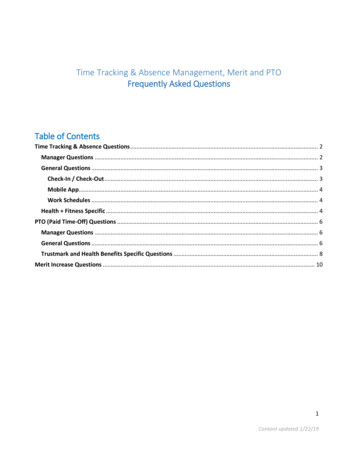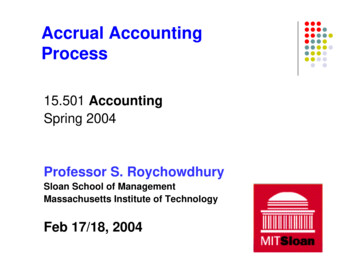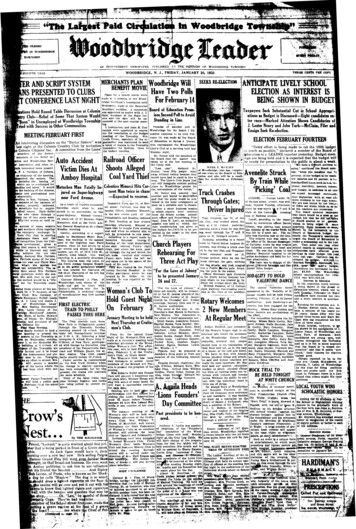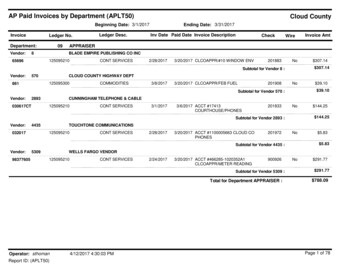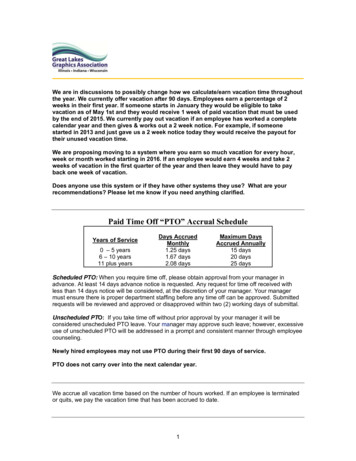
Transcription
We are in discussions to possibly change how we calculate/earn vacation time throughoutthe year. We currently offer vacation after 90 days. Employees earn a percentage of 2weeks in their first year. If someone starts in January they would be eligible to takevacation as of May 1st and they would receive 1 week of paid vacation that must be usedby the end of 2015. We currently pay out vacation if an employee has worked a completecalendar year and then gives & works out a 2 week notice. For example, if someonestarted in 2013 and just gave us a 2 week notice today they would receive the payout fortheir unused vacation time.We are proposing moving to a system where you earn so much vacation for every hour,week or month worked starting in 2016. If an employee would earn 4 weeks and take 2weeks of vacation in the first quarter of the year and then leave they would have to payback one week of vacation.Does anyone use this system or if they have other systems they use? What are yourrecommendations? Please let me know if you need anything clarified.Paid Time Off “PTO” Accrual ScheduleYears of Service0 – 5 years6 – 10 years11 plus yearsDays AccruedMonthly1.25 days1.67 days2.08 daysMaximum DaysAccrued Annually15 days20 days25 daysScheduled PTO: When you require time off, please obtain approval from your manager inadvance. At least 14 days advance notice is requested. Any request for time off received withless than 14 days notice will be considered, at the discretion of your manager. Your managermust ensure there is proper department staffing before any time off can be approved. Submittedrequests will be reviewed and approved or disapproved within two (2) working days of submittal.Unscheduled PTO: If you take time off without prior approval by your manager it will beconsidered unscheduled PTO leave. Your manager may approve such leave; however, excessiveuse of unscheduled PTO will be addressed in a prompt and consistent manner through employeecounseling.Newly hired employees may not use PTO during their first 90 days of service.PTO does not carry over into the next calendar year.We accrue all vacation time based on the number of hours worked. If an employee is terminatedor quits, we pay the vacation time that has been accrued to date.1
Our thought is employees earn vacation as they go, and once their anniversary year is up theyget credit for the vacation for the year. (We just do it annually – it makes it easier. In the casebelow, I would just give the vacation for the first year, but know they are earning vacation for yeartwo). Based on our philosophy, we pay out all the vacation that is “on the books” for an employeeat the time that employee terminates. If an employee’s anniversary date is July 1, and they quitJune 15, they do not get credit for vacation they were earning during the previous 11½ months.Here is our plan. It works for us.All full-time employees who have completed one calendar year of service (from a January 1st toDecember 31st) earn 10 days (80 hours) of paid time off per year, to be taken within the followingyear.All full-time employees who have completed five (5) calendar years of service earn 15 days (120hours) of paid time off per year, to be taken within the following year.All full-time employees who have completed fifteen (15) calendar years of service earn 20 days(160 hours) of paid time off per year, to be taken within the following year.Completed length of serviceUpon 1 calendar year completedUpon 5 calendar years completedUpon 15 calendar years completedPaid time off10 days (80 hours)15 days (120 hours)20 days (160 hours)To be taken by12/31 of that year12/31 of that year12/31 of that yearPaid time off (PTO) can be taken in whole hour increments. Part-time employees are not eligiblefor this benefit.To schedule time off, submit a PTO request form to your supervisor at least 30 days in advanceso that we may schedule workloads. Due to work commitments and previous requests for timeoff, you may not always receive the specific time period you request, and we reserve the right toschedule PTO based on business necessities.We encourage our employees to use their PTO benefit, but we know that this is not alwayspossible. Up to one week (40 hours) of unused PTO remaining at the end of the year will be paid.Any remaining unused PTO cannot be carried over into the next calendar year and will not bepaid.We do not have sick time. All time off is under the PTO umbrella.New employees who started after January 1st will have their PTO time pro-rated for the nextcalendar year based upon their start date.If an employee leaves the company, regardless of the reason, unpaid time off will not be paid out.2
We give the vacation out at the beginning of the year. Technically, an employee who leaves mayowe us if they use up vacation they haven’t earned. As our turnover is low, we found the recordkeeping required to earn vacation every week to be to0 onerous to track so we just let it go. Welooked at it from a cost/benefit standpoint.Also, are you going to restrict a good employee from taking a long vacation in the beginning ofthe year? If not, you may need to allow employees to roll over vacation (we do not).We use ADP for our payroll. We have our vacation system set up that they earn xx hours ofvacation per payroll based on their length of time with the company. ADP adds the hours eachpayroll to their balance. If the employee terminates, they are paid out the balance of their earnedvacation. We went to this system several years ago because employees would terminate, owingus vacation and no hours worked for us to use to pay back the excess vacation used.Our policy states; an employee receives one week paid vacation after 1 year of employment. Iftheir starting date is March 12, 2015, then on March 12, 2016 they are eligible for one week paidvacation, which would have to be used by Dec. 31, 2016. Vacation benefits start over on Jan. 1.All future vacation is pro-rated, using their starting date.Any employee who terminates or retires from employment is paid out any remaining vacation atthat time. And being they are earning vacation now for next year, that vacation is paid out on apro-rated basis. For instance, if an employee now has 2 weeks paid vacation & should retire onMarch 1, they would receive any remaining vacation from the 2 weeks for this year along with apro-rated for 2016 which would be 1.68 days or 2 days.This policy works very well for us.We had stated in our employee handbook that employees “earn” one week of vacation “after” oneyear’s employment. We had an employee leave our employment before one year of employmentand demanded his “earned” vacation based on how long he had been working with us. Wedenied this request. This employee filed with the Illinois Department of Labor. Long story short,the official reviewed our case and we were ordered to pay the employee the vacation that wasearned based on the percentage of the year that the employee had worked. The fact that we hadstipulated that vacation is earned “after” one years employment did not stop an employee fromearning vacation from day one on a percentage basis. If they work 156 days, they are owed 2.13days of vacation (156/365) x 5 days 2.13.We are a smaller company with about 30 employees. I have a spreadsheet where I keep track ofeach employees start date, vacation taken, earned vacation to date, and any unused from theprevious year. If an employee goes into negative vacation usage; we limit it and have theemployee sign a simple form that I have scanned that can be used or modified if anyone cares touse it.(Editor’s note: the form follows on the next page.)3
Here's our PTO/Funeral Leave policy.Paid Time OffThe company grants paid time off to regular full-time employees who are scheduled to work fortyhours or more per week. Paid time off must be scheduled and approved by your supervisor twoweeks prior to taking the time off. Company requirements and customer demands will beconsidered when approving the requests for time off. A doctor’s statement is required for threeor more consecutive sick days, in order to return to work.1. After the probationary period, employees earn one day of paid time off for eachmonth worked the next nine months. Beginning on the thirteenth month of employment, theemployee will earn one week of paid time off every four months. (Paid time off can be taken onlyafter it is earned. For example, if an employee wants to take paid time off during the months ofJanuary through April, he needs to have earned it in the prior period.2. Employees may roll-over paid time off into the next year. The maximum time that anemployee may accrue is twenty days. The company will not pay for unused days except asdescribed in paragraph 4.3. Employees may not “borrow” unearned paid time off, except as approved bymanagement. Employees who borrow PTO must sign an agreement to have equivalent paydeducted from their final paycheck in the event that employment is termination for any reasonbefore PTO is earned.4. At termination of employment, the terminating employee will automatically receiveaccrued paid time off up to a maximum of five days if that employee gave the company twoweeks notice or was terminated without cause.Funeral LeaveEmployees may take up to two days paid funeral leave to attend the funeral of a direct familymember. An additional day may be taken if the services are held outside of the Indianapolis area.A direct family member is defined as a spouse, child, parent, sibling, grandchild or grandparent.We are exploring options for vacation accruals and eligibility period as well. At present, we prorate the amount of time an employee would be eligible for on January 1 on a monthly basis; i.eemployee eligible for 10 days and leaves in the end of May would have accrued 4 days. Anybalance would be paid out; they would have to repay any excess taken.Our employees accrue their vacation time each pay period. If they get 2 weeks vacation per year,they accrue 3.08 hours of vacation each biweekly pay period. They are allowed to use vacationas soon as they have it and can use it in 1 minute increments. In order to take a full day off, theywould only have to have worked about 6 weeks. They are encouraged to save it and actuallytake time off, but generally, most use it up a few hours here and a few hours there. While thisisn't ideal for them to get time away and get refreshed, it actually works out very well forproduction, which doesn't have to deal with am employee missing for extended periods.5
Here is an excerpt from our company's policy. Please note that if an employee quits andhas used more vacation than he/she earned, it can be legally withheld with the employee'swritten permission only, and cannot be deducted if the employee has not authorized thededuction. We send a letter to the employee requesting they pay back the money, butrarely do they pay it back.Vacation days are earned during the calendar year in which they are received. Forexample, an eligible employee with two years of service will receive two weeksequivalent to his or her standard workweek that may be used, and are earned, duringthat calendar year. Vacation is earned on a monthly basis, and a person must beemployed by the company for at least 15 days of each month for vacation to be earnedin that month. For instance, an employee with 5-14 years of service whose standardworkweek is 40 hours will earn 1.25 (15 days/12 months) vacation days per month. Ifthe employee leaves the company as of the 12th of a given month, no vacation will beearned for that month. Earned vacation will always be rounded up to the nearestnumber of full days for use by an employee. (This is not the case when calculatingvacation to be paid out upon separation.) During an approved leave of absence,employees will continue to earn vacation for up to 4 months, provided they return toactive employment. After 4 months, they will no longer earn vacation until they return toactive employment.New employees will not earn any vacation days during the first six months ofemployment or re-employment. Eligible employees will receive, after completing 6months of service, a pro-rated amount of vacation days based upon the number ofmonths remaining in the calendar year. For example, an employee hired February 1whose standard workweek is five days per week will receive on August 1, aftercompleting 6 months of service, 5 vacation days that will be earned, and should be takenin the last five months of the calendar year (10/12 x 5 4.17 rounded up to 5 wholedays). The employee will be eligible for 10 days vacation during his or her secondcalendar year of employment. Another example: an employee hired October 1 with thissame standard workweek will receive on April 1, after completing 6 months of service, 8vacation days that will be earned, and should be taken during the last 9 months of thecalendar year (10/12 x 9 7.50 days rounded up to 8 whole days). The employee will beeligible for the full complement of 10 days vacation during his or her next calendar yearof employment.Vacation may not be carried over from one calendar year to another or borrowed fromfuture years.6
Here is an excerpt from our PTO policy on how it is prorated for new hires and then upontermination:While PTO is earned at 1/12 of the benefit each month, an employee may use his/her Paid TimeOff allotment at any point during the calendar year. New employees are eligible to use Paid TimeOff following 90 days of employment (waived for employees hired after September 1st). Anemployee must be actively working to earn Paid Time Off; no time is earned during a leave ofabsence.If an employee should leave the company, the balance of his/her earned but unused Paid TimeOff allotment will be paid out upon termination. We will attempt to reconcile any overpaid PTO attime of employee’s final pay.I have two PTO plans running at the moment. One in Chicago in which employees earn PTO ontheir anniversary date in a lump sum. The other is in another city, where a city ordinance for sicktime ends up causing us to calculate earned time per hour worked. I like the Chicago modelbetter– one, it is simple for everyone to understand and administer and two, because we arerequired to keep a year-end financial reserve for earned but not taken PTO on our financialstatements. Earning PTO in one lump sum reduces that reserve and allows HR to contribute tothe bottom line in a meaningful way.Nonetheless, looks like sick time will be a requirement for all businesses in the next few years –ie – Congress’ Healthy Families Act. In that one and the other city ordinance, companies havethe option of allowing current PTO plans to be used for sick time and adjusting your plan to therequirements of the regulation (like how time is earned, carried over, etc) or you can add therequired amount of sick time in addition to the PTO benefit already offered. I chose in that city tomake the PTO comply with the sick time ordinance over adding more days off for everyone.However way you decide, I think you should consider the potential impact of sick day legislation.Hope this is helpful.We do not offer personal days or any type of discretionary time off. Employees accrue PTO timemonthly and can only use what is accrued. Employees are allowed to use 16 hours of unearnedPTO time but that is it. New employees earn two weeks of PTO time per year. At the third yearemployees start earning three weeks of PTO time per year.We don’t accrue our vacation throughout the year. All employees get their full allotment of hourson 1/1 of every year to use as they need to. Employees can roll over a max of 104 hours fromyear to year.7
We implemented a very similar system 2 years ago.Full-time Employee Owners Full-time employee owners accrue vacation for each pay periodworked during the calendar year, on a pro-rata basis. During the calendar year, employee ownerswill be allowed to use their vacation prior to accruing it. (See Termination of Employment below.)Full-time employee owners can accrue the following vacation benefits during the current calendaryear:1 st full year 80 hours effective January 1 or 90 days from hire date, whichever is later.2nd thru 4th years 80 hours per year, effective Jan. 1.5th thru 14th year 120 hours per year, effective on Jan. 1 of the year the employee ownercompletes his/her 5th year of employment.15th thru 20th year 160 hours per year, effective Jan. 1 of the year the employee ownercompletes his/her 15th year of employment.21st thru 24th year An additional 8 hours per year effective on Jan. 1.25th year/beyond 200 hours per year, effective Jan.1 of the 25th year.Example: John started full-time employment on Wednesday, January 16th. He will be eligible tobegin taking vacation on April 15th. Provided he remains employed the entire year, he will beeligible to take 77 hours from April 15th through December 31st . Calculation: 80 hours/26 payperiods 3.08 hours per pay period 3.08 hours per pay period * 25 pay periods (the number ofpay periods John would work during the calendar year) 77 hoursTermination of Employment If an employee owner terminates employment, the amount ofaccrued vacation, less any taken vacation, will be paid out. If an employee owner has taken morevacation than what he/she has accrued at the time of termination, the overage will be deductedfrom the employee owner’s last paycheck. This provision applies to all employee owners.Example: Suzy has six years of service. Had she worked the entire year, she would’ve accrued120 hours. She terminated on June 30th. At that time she had accrued 60 hours. A. She took 40hours of vacation. She will be paid out 20 hours of vacation. B. She took 80 hours of vacation. 20hours of vacation will be deducted from her last paycheck. If an employee owner terminates priorto completing one full year of employment, vacation pay will not be paid out, but overage will bededucted from the final paycheck.We use a similar accrual method. Our employees earn so much per week. They receive oneweek paid vacation after their initial 60 days for the first year. They earn .93 hrs per week. Atone year they receive two weeks or 1.54 hrs per week. At ten years they receive three weeks or2.31 hrs per week and so on. At the end of the year, the employee can roll over whatever levelthey are currently earning. So, if they are at the two week level they can roll 80 hours over to thenext year. This way the employee can, in theory, always have vacation time available if they planaccordingly.We have the policy in place that you are considering. Every employee earns their vacation andwe do let them take more vacation than earned to avoid having the entire company taking time offat the end of the year. However if a person takes more time off than earned and leaves thecompany we do withhold that amount from their final check.On every paycheck there is a spot that shows the employee how many days of vacation theyhave earned8
We have an accrual-based PTO plan that this member may find very useful. See below.-------------------The Company encourages employees to take available time off and allows time off to be used forany reason. If all time is used for leisure nothing will be left to protect an employee’s incomeagainst unexpected absences. Employees are encouraged to use this benefit to ensure a goodpersonal balance between leisure and those unexpected absences which affect us all. PTOshould be scheduled to interfere as little as possible with the normal operation of business and toavoid excessive workloads for other employees.PTO is available to Full-Time employees working at least 30 hours per week. Full-Timeemployees begin earning PTO immediately.Active employees will not be paid out accrued PTO at any time during the year.PTO must be taken in no less than 1-hour increments and is paid at the employee’s base rate atthe time of absence. It does not include overtime. If a Co
Paid Time Off “PTO” Accrual Schedule Years of Service Days Accrued . We are a smaller company with about 30 employees. I have a spreadsheet where I keep track of each employees start date, vacation taken, earned vacation to date, and any unused from the previous year. If an employee go
